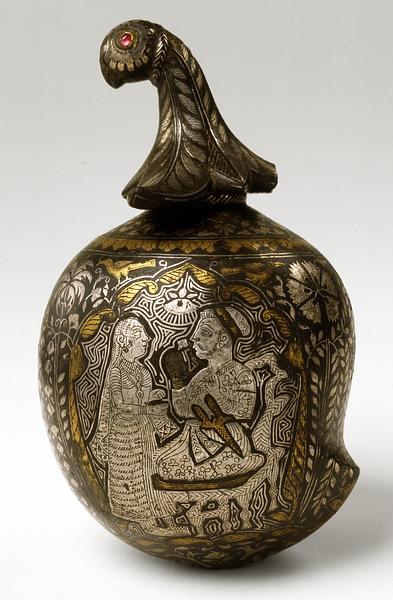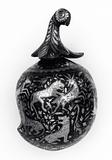Flacon, bidri metal, inlaid with silver and brass
India, Deccan; 2nd half of 17th century
H with stopper: 13.7 cm
Bidri metal is an alloy of zinc, copper, tin, and lead that after finishing has a deep, matte-black surface that is normally inlaid with other metals. The metal takes its name from the city of Bidar, where the technique was probably developed. Later it also spread to northern India.
This mango-shaped container was undoubtedly made to contain the lime paste that was used for chewing betel nuts. Organic shapes are often used in Indian and Indian Islamic art. Here the mango was combined with a stopper that can be interpreted both as a stem and as a parrot. The figurative inlay is both rare and of high quality.
Inv. no. 1/1993
Published in:
Kjeld von Folsach, Torben Lundbæk and Peder Mortensen (eds.): Sultan, Shah and Great Mughal: the history and culture of the Islamic world, The National Museum, Copenhagen 1996, cat.no. 346;
Mark Zebrowski: Gold, silver and bronze from Mughal India, London 1997, fig. 410 and fig. 370;
Kjeld von Folsach: Art from the World of Islam in The David Collection, Copenhagen 2001, cat.no. 537;
Sheila S. Blair and Jonathan M. Bloom (eds.): Cosmophilia. Islamic Art from the David Collection, Copenhagen, McMullen Museum of Art, Boston College, Boston 2006, cat.no. 9;
Kjeld von Folsach: Flora islamica: plantemotiver i islamisk kunst, Davids Samling, København 2013, cat.no. 68;
Ravinder Reddy: Arms and armour of India, Nepal and Sri Lanka: types, decoration and symbolism, London 2018, p. 51;


